This section contains entries about our botanizing in Baja California written for the UC BEE (Oct 2012 to Aug 2021)
and The UC Bee Hive (2022-), monthly newsletters for volunteers and staff of the UC Berkeley Botanical Garden.
Click on any photo for a larger image.
BEE FEBRUARY 2013
Ensenada Symposium – More Fall Flowers
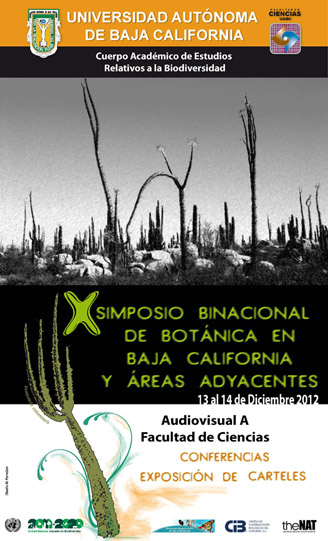 Right after finishing last month's BEE article in mid-December, we made a trip to Ensenada to attend the 10th Botanical Symposium for Baja California and Adjacent Areas being held at the Autonomous University of Baja California (UABC). I gave a talk where I introduced my bilingual Trail and Plant Guide for Mesa del Rincón, San Ignacio, BCS that I completed late last summer. If you’re interested in the guide, you can find both monolingual versions to download for free, or you can purchase a bilingual electronic book at this link on my website. Contact me for a spiral-bound, bilingual copy.
Right after finishing last month's BEE article in mid-December, we made a trip to Ensenada to attend the 10th Botanical Symposium for Baja California and Adjacent Areas being held at the Autonomous University of Baja California (UABC). I gave a talk where I introduced my bilingual Trail and Plant Guide for Mesa del Rincón, San Ignacio, BCS that I completed late last summer. If you’re interested in the guide, you can find both monolingual versions to download for free, or you can purchase a bilingual electronic book at this link on my website. Contact me for a spiral-bound, bilingual copy.
 There were approximately 30 papers and numerous posters that were presented during the two days of the symposium, which was attended by about 50 researchers and graduate students from a number of universities and institutions in both Baja California states, as well as by botanists from the United States. The conference was a great time to meet new people, and catch up with old friends who are working on, or interested in, the flora of the peninsula. Some of the topics addressed were: archeobotany; exotic and invasive plants; floristics of different peninsular regions; the rare, endemic and endangered species of the California Floristic Province within Baja California; and a National Strategy for Plant Conservation.
There were approximately 30 papers and numerous posters that were presented during the two days of the symposium, which was attended by about 50 researchers and graduate students from a number of universities and institutions in both Baja California states, as well as by botanists from the United States. The conference was a great time to meet new people, and catch up with old friends who are working on, or interested in, the flora of the peninsula. Some of the topics addressed were: archeobotany; exotic and invasive plants; floristics of different peninsular regions; the rare, endemic and endangered species of the California Floristic Province within Baja California; and a National Strategy for Plant Conservation.
The new Baja California Plant Field Guide was also available for sale and its principal author, Jon Rebman, Botany Curator at the San Diego Natural History Museum and my botany mentor, discussed in different sessions both the Guide and the fascinating results from one of his and his co-authors' latest field studies in the Sierra La Libertad in central Baja California.
Field Notes — Dec 22, 2012
The temperatures have been slowly cooling down here in Mulegé over the past month. However, winter annuals are continuing to sprout, while the mosses are dying back in some areas and continuing on in others. The liverworts (Riccia cavernosa) are reaching their maximum size of 3 cm while many have dried up and disappeared into the background soil along with the rest of the biological soil crust.
After we came back from Ensenada, we went out to check on the bryophytes in the palm orchard. While looking around, we found two species of Erythranthe [Mimulus], very small flowered annuals that like to grow in damp places here in Baja California. These are both new records for my flora inventory of the Mulegé region, bringing it, to date, to a total of 347 (up from 333 when we first arrived).
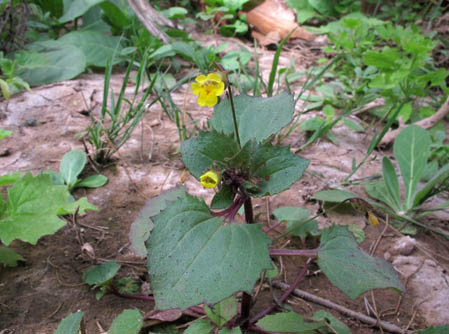
Erythranthe [Mimulus] brevinasuta (Phrymaceae).
Short-tooth monkeyflower. Annual known mostly from the Sierra La Giganta on the Peninsula, northern Mexico and east of the Rockies in the US.
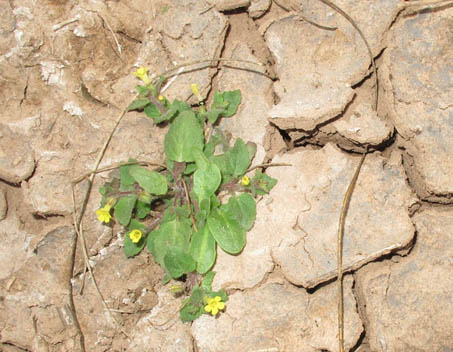
Erythranthe [Mimulus] floribundus (Phrymaceae).
Many-flowered monkeyflower. This is a fairly common species in BCS
around springs & intermittent water courses. This plant is 10-15 cm D.
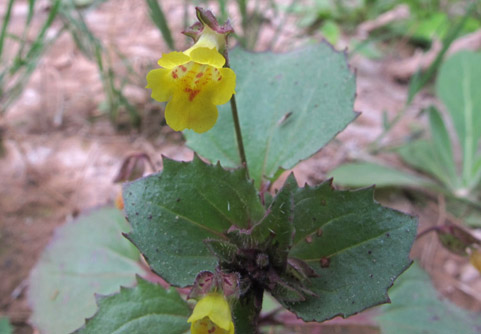
Erythranthe [Mimulus] brevinasuta.
Short-toothf monkeyflower.
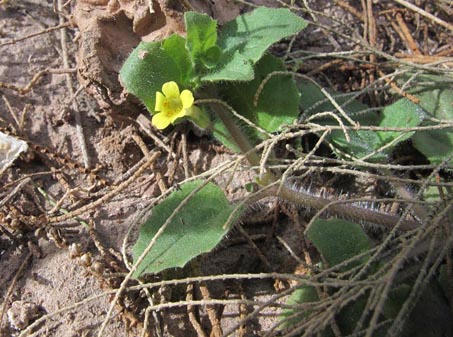
Erythranthe [Mimulus] floribundus has a prostrate to decumbent habit and in contrast to the previous Erythranthe, it is very hairy. Click on the photo for a better look at the erect, shiny hairs on the stems above. The flowers are smaller (about 6-7 mm L x D).
Field Notes — Dec 30, 2012
This has been a very full and productive year and while there have been ups and downs, it has ended on a good note. My article about my bilingual San Ignacio trail and plant guide went up on-line today in the Spanish  version of Melóncoyote, an environmental newspaper about sustainable development in the Gulf of California region. For those of you interested in learning about the issues affecting the Gulf region, with most of the articles written from a local perspective, the newspaper is available on-line in both the original Spanish and translated English version (I head up a team of translators for the newspaper and manage the site). My article and the entire latest edition in English are now available.
version of Melóncoyote, an environmental newspaper about sustainable development in the Gulf of California region. For those of you interested in learning about the issues affecting the Gulf region, with most of the articles written from a local perspective, the newspaper is available on-line in both the original Spanish and translated English version (I head up a team of translators for the newspaper and manage the site). My article and the entire latest edition in English are now available.
Field Notes — Jan 6, 2013
I’d been watching these vines since we got here in early November and while I knew it was a milkweed, I had no other clues to help with its identification. I had not seen them in this region before, and was very curious to find out what the plant was once it bloomed.
After traipsing through the fields in the palm orchard over many weeks, perhaps risking life and limb (snakes!? and holes hidden under the heavy cover of amaranths and grasses), I finally found a vine with flowers on it. This milkweed is common in southern California in the more arid regions.
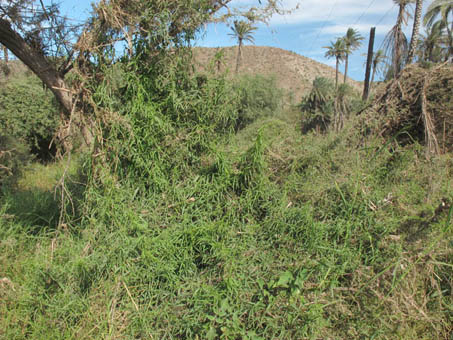
Funastrum hartwegii (Apocynaceae). Climbing milkweed habit, with it's twining slender stems. I think the milky latex sap smells very much like onions.
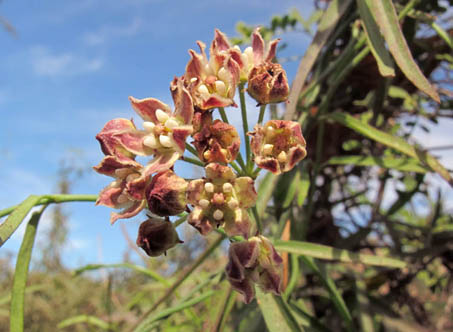
Funastrum hartwegii (Apocynaceae). Climbing milkweed flowers with its maroon or purplish, hairy petals. Not many blooms yet or signs of fruit.
And to end this BEE entry, I'll leave you with a few final photos of pretty little annuals popping up all over the palm orchard and along the various courses of the valley's arroyo...
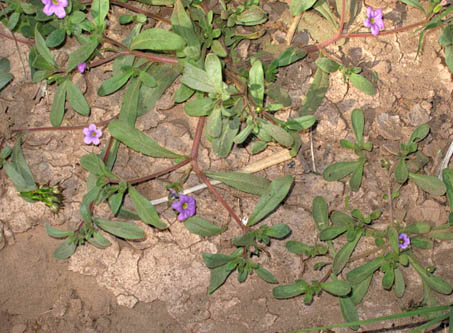
Nama coulteri (Boraginaceae). This hairy, slightly glandular annual has a prostrate to
decumbent habit. Some species are known as Purplemat.
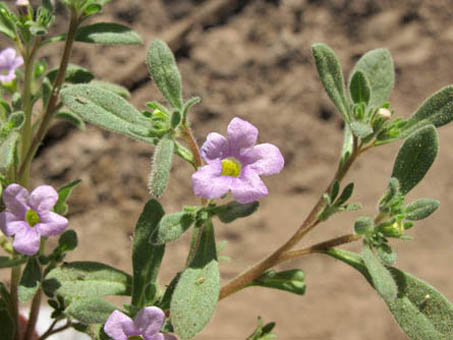
Nama coulteri. This species is mostly found in sandy or silty soils of arroyos and around waterholes. The campanulate flowers are about 7-10 mm D.
Until next time...Hasta la proxima!
— Debra Valov, curatorial volunteer


 Right after finishing last month's BEE article in mid-December, we made a trip to Ensenada to attend the 10th Botanical Symposium for Baja California and Adjacent Areas being held at the Autonomous University of Baja California (UABC). I gave a talk where I introduced my bilingual Trail and Plant Guide for Mesa del Rincón, San Ignacio, BCS that I completed late last summer. If you’re interested in the guide, you can find both monolingual versions to download for free, or you can purchase a bilingual electronic book at
Right after finishing last month's BEE article in mid-December, we made a trip to Ensenada to attend the 10th Botanical Symposium for Baja California and Adjacent Areas being held at the Autonomous University of Baja California (UABC). I gave a talk where I introduced my bilingual Trail and Plant Guide for Mesa del Rincón, San Ignacio, BCS that I completed late last summer. If you’re interested in the guide, you can find both monolingual versions to download for free, or you can purchase a bilingual electronic book at 








